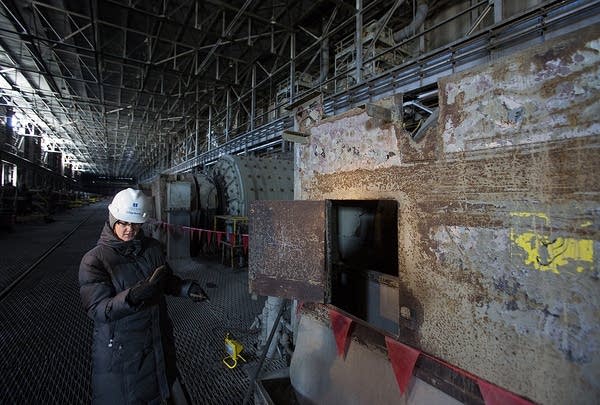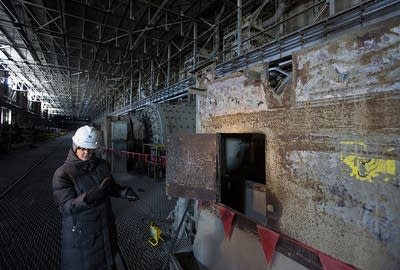On the Iron Range, debating whether long-term prosperity follows more mining
Go Deeper.
Create an account or log in to save stories.
Like this?
Thanks for liking this story! We have added it to a list of your favorite stories.

Inside the old LTV Taconite Plant, huge grinding mills, each larger than a cement truck, are lined up one after the other in a space the size of several football fields.
The mills sit inside an enormous metal building that has been vacant since 2000, when the operation closed. But it soon could be bustling with activity, much like it was in the 1990s, when 1,400 workers held good-paying jobs there.
"If you take a look inside, you can actually see there are rods of different sizes in here," said LaTisha Gietzen, a spokeswoman for PolyMet, the mining company that wants to breathe new life into the plant. "They break down all of the different rocks into smaller sizes."
Mining has always been a boom and bust industry on the Iron Range. But proponents of the PolyMet plant, and another proposed copper-nickel mine by Twin Metals, say the area is poised for a rebound.
Turn Up Your Support
MPR News helps you turn down the noise and build shared understanding. Turn up your support for this public resource and keep trusted journalism accessible to all.
While backers of the mines emphasize the jobs they could bring, opponents ask whether those jobs are worth the environmental risk to the region's lakes and rivers. A recent University of Minnesota, Duluth study adds fuel to the debate over controversial new copper-nickel mines in northern Minnesota, which are often framed as "jobs versus the environment."
The study predicted that several mining projects -- both copper-nickel and new iron ore developments -- could generate billions of dollars' worth of economic activity.
Gietzen said the mine would create 360 jobs, with an additional 600 spinoff jobs at local businesses. That's a big deal in St. Louis County, where the unemployment rate is about 6.5 percent.
"I heard one of our local elected officials say once, if you lose a job in the Twin Cities, you drive another 10 miles to find one," Gietzen said. "If you lose a job in Hoyt Lakes, you're not driving 10 miles to find another job."
In addition to PolyMet, several other new mines and expansions are in the works on the Range. The UMD study predicts that combined with already existing mines, they could result in 27,000 jobs and an overall economic impact of $7.7 billion by 2016. The vast majority of those jobs are the result of iron ore projects, which are still king on the Iron Range.

UMD economist Jim Skurla wrote the study, which was funded by mining groups and state agencies. He points to projects like Essar Steel's taconite plant being built in Nashwauk, a $1.8 billion project that will create 350 permanent jobs and more than 1,000 construction jobs.
"These are huge projects, and that's one thing people have to realize," Skurla said. "These aren't tiny little operations that are going on. So when the mining industry does things, they do things in a big way."
But even with such big projects, not everyone is convinced the short-term benefits are worth it. Among those who have doubts is Betsy Daub, policy director for Friends of the Boundary Waters Wilderness, a group that recently has worked to stop proposed copper-nickel mines like PolyMet.
Daub said in the long term, mines often fail to create thriving communities.
"What we find in almost every study that is done looking at mining-dependent communities ... they have some of the highest unemployment rates around," Daub said. "They have some of the highest poverty rates. They have stagnant or declining populations, not growing populations."
Two environmental groups, the Sierra Club and the Minnesota Center for Environmental Advocacy, commissioned one of those studies in 2006, from University of Montana economist Thomas Power. Power, who has long been skeptical of the promises that mining companies often make, said mining historically hasn't been an economic panacea.

"We have hundreds of years of history with mining. It's staring us in the face on the Iron Range or the Upper Peninsula or Butte, Montana," Power said. "How is it that despite the high wages, and despite the incredible wealth pulled out of the ground, these areas are not prosperous?"
In St. Louis County, where most Minnesota mining is concentrated, the unemployment rate of 6.6 percent is more than a point higher than the statewide average of 5.4 percent. The county's poverty rate of 16.2 percent is the sixth highest rate in Minnesota, well above the state average of 10.1 percent. Many Iron Range communities have seen their populations shrink.
But to people like Jim Lassi, a City Council member in Babbitt, a small town near two proposed copper-nickel mines by PolyMet and Twin Metals, that's exactly the reason these new projects are so desperately needed.
"So many of our small businesses are struggling," he said. "We're really counting on this to get this influx of people to stabilize our economy and boost us up."
Lassi said Babbitt is already making plans for a possible boom by updating its comprehensive plan to prepare for new housing developments and upgrades to utilities and other services. He thinks Babbitt could grow to around 3,000 residents.
"I think that would be max," he said. "That would mean we'd have to double."
People like Lassi are frustrated by PolyMet's now eight-year-long environmental review process. But he hopes Babbitt moves one step closer to a possible economic payday this summer, when the project's revised impact study is set to be released.
Editor's note: An earlier version of this story incorrectly reported that Friends of the Boundary Waters Wilderness was one of the sponsors of a 2006 University of Montana study on the economic impacts of mining. The current version is correct.



